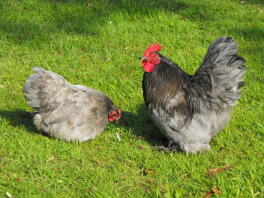Brahma høne








Brahma History
Brahmas arrived in the UK around 1840-1850. The name Brahma comes from the river Brahmaputra in India although the species was created in America from large feather legged birds known as Shanghais which were imported from China in the 1840s. These were crossed with Grey Chittagongs from India which produced the pea comb and beetle brow that we see in the Brahma today. They are sedate birds with broad, deep bodies, full breast and long powerful, orange or brilliant yellow legs and feet covered with abundant soft feathers which produces lovely big floppy feet. The head is small for such a large bird and the face is smooth and free from feathers with large, prominent eyes, short strong beak and a triple or pea comb and small wattles. The brow is broad which produces heavy eyebrows. They are well known as being one of the largest breeds of chicken and are often called \'The King Of Chicken Breeds\'.
Brahma Behaviour
Brahmas are very large, stately, docile birds who make good reliable broodies which can cover a large number of eggs due to their size. The eggs are small and low in number but chicks hatch strongly and grow quickly. Their feathering is beautiful and they are very elegant birds. They will happily stay behind 2-3 foot fencing and prefer dry conditions because of their foot feathering they can develop mud balls (or fecal balls) on their toes. If this is not removed, the loss of nails or the tips of the toes may result. They are slow maturing and take two years to reach maturity. They are trusting birds and are easy to tame. Because of their size, they do take up a lot of space but they do not fly and can be let out to roam happily in the garden. Hens don't start to lay until they are around six or seven months old and the eggs are as small as those of the larger miniature breeds. They do continue laying throughout the winter unlike some pure breeds. They are tolerant towards other breeds so can be kept together with other varieties without any problems and can even be submissive towards others despite their large size. Even cocks will tolerate each other. They make very little noise and even the cockerels do not crow particularly loudly. The profuse feathering makes them very good at withstanding cold winter weather.
Brahma Varieties
Dark, light, white, gold, buff Columbian. In all colours, the eyes, comb and earlobes are red and the legs are bright yellow.
Brahma Status
Rare
Billeder af Brahma





























Brahma For Sale
Please note:
Alle dyr anført her er kun til afhentning. De kan ikke leveres af sælger eller af Omlet. Sælgeren sender dig deres kontaktoplysninger for at arrangere betaling og afhentning.
Sell Yours Here
det er gratis
Sorry, there are currently no Brahma listed for Sale












